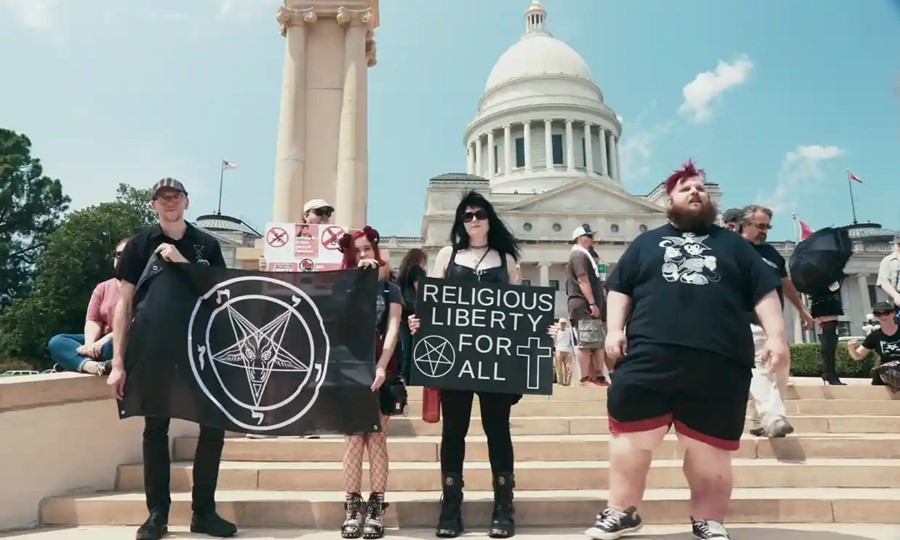In the midst of what has been a terrifying couple of weeks for online conservative forums and Mumsnet, Dazed spoke to some actual satanists to get the rundown on what is really going on
Lil Nas X’s blood-infused trainers, the Balenciaga controversy and even Dazed’s Doja Cat cover: Satanic Panic is making a big comeback in 2022. As you can explore further in our deep dive into the moral panic circulating online recently, social media is rife with accusations that cultural icons and fashion brands are engaging in devil worship and shadowy misdemeanours. These include child grooming, ritual abuse and an agenda to indoctrinate minors into sexualised lifestyles, mirroring the original wave of terror that went on in the 80s and early 90s.
The fears around satanism are understandable. For a lot of conservatives and people of faith, even if they don’t believe all satanists are devil worshippers and child groomers, there’s still a lot of discomfort around the idea: Satan is, after all, supposed to be the embodiment of evil. Most modern-day satanists, however, would argue that their beliefs are closer to a kind of anarchic atheism – their purpose is more about offering a provocative, probing counternarrative to the evils of institutional religion. As the Satanic Panic gets whipped up once again, this reality becomes distorted.
La Carmina, author of The Little Book of Satanism: A Guide to Satanic History, Wisdom and Culture, attributes the moral panic “to the continued breakdown in trust in institutions and increase in political tribalism,” she tells Dazed. “Time and time again, Satan has been made the scapegoat whenever it was convenient for one side to demonise another. Many mediaeval Christians accused other faiths, minority groups, and even other Christian denominations of being satanists in order to discredit and persecute them.”
“It’s telling that many of the celebrities being accused of satanism are successful people of colour,” she continues. “I think the rise of political extremism, theocratic interference in politics, and addictive social media algorithms – particularly in the US – have an enormous role in pushing satanic conspiracy theories that target influential creatives of colour. I think if people are willing to learn what satanism really is, they’ll realise it isn’t as controversial a subject as they might have thought. Rather, what’s shocking is the way that conspiracy theorists have falsely associated individuals with the Devil over the centuries, with terrible consequences for innocent victims.”
But what do real-life satanists think about all this? Is it helpfully shining a light on the truth behind their practice, or demonising their ideologies even further? We spoke to three self-described satanists to find out what they make of the heightened interest, and alarm, around all things satanic.
MIKAYLA LOFFREDO, 19
“Social media and online clickbait have really pushed people into believing that people like me eat babies every day. Everyone wants something to be angry about, and the idea of satanic imagery and what it is changes to fit people’s narratives. If you, as a consumer of media, don’t like ‘edgy’ things, why make that everyone else’s problem? I remember when Lil Nas X released the “MONTERO” music video and people were trying to connect the video with a ‘New World Order’ conspiracy theory. The same thing is currently happening with Balenciaga as well – you will find lots of people saying that the brand is run by satanic overlords or lizard people trying to recruit the next generation of lizard rulers. I think this is happening only because people are too scared of the word ‘Satan’ and anything related to it.
“My only wish for the world is that people try to learn about things that scare them. I can’t imagine living in fear my whole life over something that can be easily explained and researched. I’ve had tons of people contact me [amid the new Satanic Panic], and a good 15 per cent are looking for knowledge about what satanism really is. The others are simply there to berate me for “exposing children to Satan” or just participating in the religion. I have definitely felt an uptick in negative comments. At this point, I find it hilarious, but there was a time when I wasn't as thick-skinned. Constantly having people wish you death or any form of suffering under the guise of Jesus really took a toll on my mental health.”
NIKKI, 17
“People have the wrong impression of satanism. For example, Lil Nas X uses imagery related to hell, but most satanists don’t believe in heaven and hell. We believe in reincarnation or the infinite end. That’s why Satan (in my instance, Baphomet) wants us to live our lives happily and doesn’t make up rules to control us. We believe that now is the time you need to enjoy.
“Satanism is about loving, respecting and accepting ourselves. It teaches us that we don’t have to be afraid about being us” – Nikki
“People also misunderstand that there is satanism and occultism, and they are two different things. The occult is about sacrifices and things like that. We do sacrifices too, but it’s not as bad as they make it out to be: we sacrifice wine, money and our blood – but not the blood of others. There are some satanists that took things too far and sacrificed humans and animals back in the day, but I would like to think that they’re not in our group. Satanism is about loving, respecting and accepting ourselves. It teaches us that we don’t have to be afraid about being us.”
A SPOKESPERSON FOR THE CHURCH OF SATAN
“Artists and revolutionaries have a long history of invoking satanic symbolism to express anti-authoritarianism, and cultural regressives have a long history of pearl-clutching in response. However, while Lil Nas X is an artist who intentionally utilises satanic imagery to rebel against Christian authoritarian homophobia, Balenciaga is a fashion company being accused of satanism because cowardly conspiracy theorists find ways to be afraid of teddy bears and shoes.”
